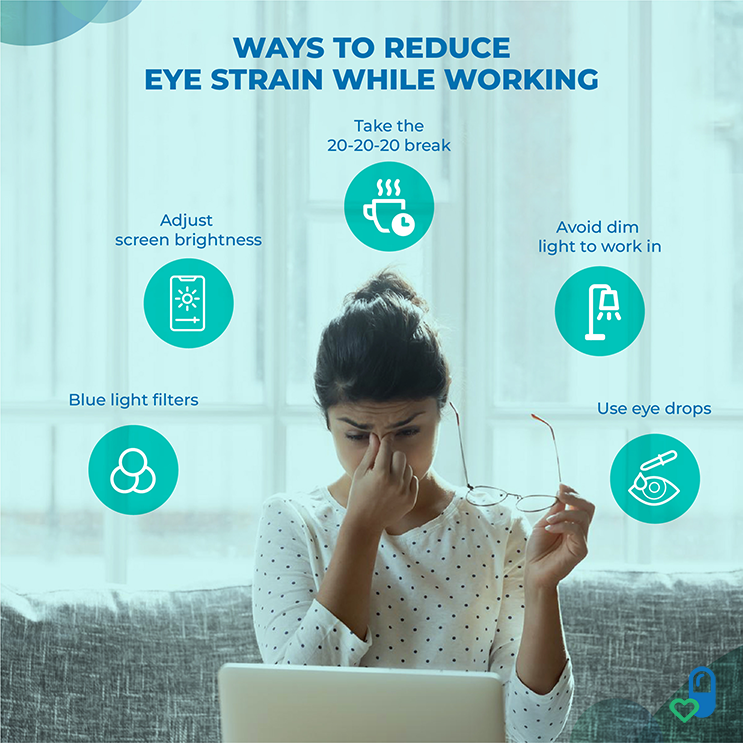How to relieve Eye Strain While Working on a Computer
Last updated on : 15 Jul, 2024
Read time : 7 min
Why does Computer Vision Syndrome happen?
Computer Vision Syndrome (CVS) is the visual fatigue caused by prolonged use of computers, smartphones, tablets other digital devices. It is also known as eye strain from computer or digital eye strain. Computer or screen use accounts for over 75% of our everyday activity. Sixty million computer professionals around the world suffer from computer eye strain.
Maximum patients visiting the optometry clinic experience eye strain from computer with the following symptoms:
- Fatigue
- Wet eyes
- Headaches
- Vision distortion
- Neck and shoulder discomfort
- Muscle spasm
- Focusing difficulty
- Intense burning sensation in the eyes
- Dual vision
- Migraine
- Light sensitivity
- Twitching of the eyes
Computer Vision Syndrome progression is influenced by several factors, including:
- Using a computer for an extended period
- Blue light exposure from the computer screens
- Inadequate lighting or glare on the computer screen
- Sitting too near or too far away from the computer screen
- Viewing the computer screen from an incorrect angle
- Those with eye errors such as nearsightedness, farsightedness, or astigmatism
Why Do Screens Cause Eye Strain/Eye Fatigue?
Along with the screen, two more factors cause eye strain from computer. It includes blue light emission from the screen and reduced blinking while watching it.
The computer screens emit blue light and require the eyes to constantly adjust focus and align, which causes eye strain and fatigue. Blue light is a high-energy visible light emitted by computers, smartphones, tablets, and televisions. Blue light penetrates deeper into the eye and causes more retinal damage than other colours. It also disrupts the sleep-wake cycle. That is why we experience eye strain, headaches, and dry eyes on prolonged screen exposure.
In addition to blue light, screens can cause eye strain and fatigue because they require the eyes to adjust focus and alignment constantly. Screens make our eyes track moving images while watching a video or playing a game, which can cause additional eye strain. Unlike printed text, which is usually fixed and stable, digital text can appear blurry or pixelated, requiring the eyes to work harder to focus.
Blinking is essential for keeping the eyes moist and lubricated. However, we tend to blink less than usual while using a screen. Furthermore, we tend to blink less while focusing on the screen, which causes dry and irritated eyes.
The Impact Of Screen Brightness On Computer Vision Syndrome
Using the screen at full brightness mode makes it difficult for your eyes to adjust the contrast between the bright screen and the surrounding environment. It also causes glare, which is the reflection of light off the screen’s surface. Glare can cause discomfort and make it difficult to see the screen. It can lead to eye discomfort, fatigue, and headaches.
Bright screens also disrupt our natural sleep-wake cycle by suppressing the production of melatonin, a sleep-regulating hormone. Excessive bright screen exposure before bedtime can make it harder to fall asleep and cause sleep disorders.
Importance Of Taking Regular Breaks From Computer Screens
While sitting in front of the screen continuously, we can have dry eyes, and neck and shoulder pain due to poor sitting posture. A regular break from the screen after 20- 30 mins can help reduce eye strain, prevent our eyes from drying, and relieve tension in the neck and shoulder muscles.
Regular breaks from the screen can also reduce stress and improve our work productivity by enhancing focus and concentration. Research has proven that short breaks can boost mental clarity and increase productivity.
Additionally, taking short breaks to stretch or walk around can keep us physically active, increase blood circulation and reduce the risk of obesity, heart disease, diabetes, and other seating problems.
Risks Associated With Computer Vision Syndrome
If you are dealing with CVS, you are at high risk of developing more severe visual problems such as:
- Myopia or nearsightedness: It is a visual condition where the eyes cannot focus on distant objects. Prolonged computer use can cause your eyes to elongate, leading to myopia.
- Astigmatism: It is a condition in which the cornea or eye lens has an irregular shape, causing uneven focus and blurred vision. Excess screen time can lead to astigmatism.
- Glaucoma: The changes in posture due to prolonged sitting can affect the pressure inside the eye and decrease blood flow to the optic nerve, leading to nerve damage over time.
- Dry eye syndrome: Decreased blinking while staring at a screen for a long time causes tears to evaporate too quickly. It results in a dry and irritated eye.
8 Tips For Computer Eye Strain Relief
Sitting in front of the screen is unavoidable. However, there are a few changes that you can implement to reduce and prevent digital eye strain from computer.

- Take regular breaks from the computer screen to prevent eye strain and fatigue. It is recommended to take a 20-second break after every 20 minutes and look at something 20 feet away.
- Adjust your screen’s brightness, contrast, and font size to make it more comfortable to view.
- Using proper lighting and positioning your computer screen will help reduce eye strain. Avoid working in a dim light room or natural light that is shining directly on the screen.
- Blink often to keep your eyes moist and prevent dryness and irritation.
- Take a day off from contact lenses, and use glasses.
- Position your screen about an arm’s length away and slightly below eye level to reduce computer eye strain.
- Use eye drops to relieve dryness and irritation caused by prolonged computer use.
- Use blue light filters, available in various forms, including software programs that adjust the screen’s colour, blue light filter glasses, and screen protectors for digital devices.
Also, get routine eye checkups to diagnose underlying eye problems and ensure your glasses or contact lens prescription is current. By implementing these tips, you can reduce eye strain from computer use and prevent more serious eye problems.
Also check- Home remedies for eye pain
Frequently Asked Questions
Get enough rest and wear glasses or contact lenses to relieve headaches. Positioning the screen at the appropriate distance and height can also reduce headaches.
You can use a cold compress by placing a chilled ice pack over your closed eyes. It is the most effective tired eyes remedy to reduce swelling and soothe the eyes. You can also place the rose water-soaked cotton ball or cucumber slices over the eyes for a soothing effect. Eye exercises such as focusing on distant objects, rotating your eyes, and blinking rapidly for a few minutes can also help to reduce eye strain from computer.
Eye strain can resolve within a few hours to a few days with rest and self-care measures. If you experience persistent or worsening eye strain despite self-care measures, consult an eye doctor for a thorough diagnosis.
Blue light glasses can help cut a significant amount of blue light that enters the eyes, which reduces eye strain and improve sleep quality. Blue light is the high-energy visible light emitted by smartphones, computers, and televisions. It can contribute to eye strain, headaches, and disrupted sleep.
Disclaimer: The information given in this article is true to our best knowledge. Still, we recommend that you consult your doctor before taking any treatment to relieve eye strain from the screen mentioned in this article.
References
Disclaimer
Our healthcare experts have carefully reviewed and compiled the information presented here to ensure accuracy and trustworthiness. It is important to note that this information serves as a general overview of the topic and is for informational purposes only. It is not intended to diagnose, prevent, or cure any health problem. This page does not establish a doctor-patient relationship, nor does it replace the advice or consultation of a registered medical practitioner. We recommend seeking guidance from your registered medical practitioner for any questions or concerns regarding your medical condition.
Popular Articles
Recommended Articles
Recent Articles
Top-Selling Medicines:
...View more
Top-Selling OTC:
...View more
Subscribe
Claim your complimentary health and fitness tips subscription and stay updated on our newest promotions.
Download Truemeds
Manage your health with ease Download Truemeds today!Get easy access to medicine refills, health information, and more. With our app, you'll never have to wait in line again. Download now and start taking control of your health.

Contact Us
Our customer representative team is available 7 days a week from 9 am - 9 pm.
v3.5.0
Our Payment Partners




























































